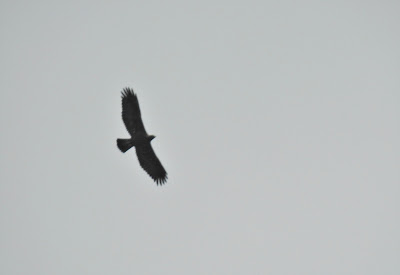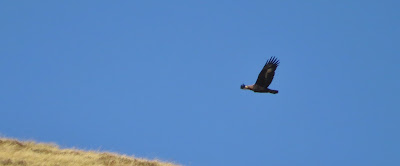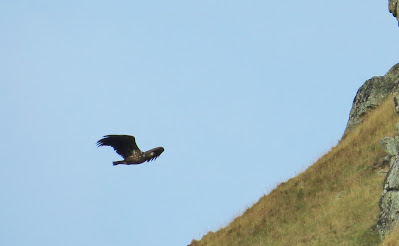October 2022
October 2022 was very changeable weather-wise in this area, but overall, it is fair to say that it became generally more autumnal as the month progressed, although the last few days did see us enjoy above average temperatures. Although no extreme weather was experienced, it should be noted that sun, wind, rain, sleet and even a few light snow showers can all be experienced in October, sometimes in the same day, so any prospective visitors would be wise to pack a good variety of clothing.
Temperature ranged widely from a balmy +15c to a chilly -3c, and the few bright and sunny days saw us get our first proper frosts of this autumn, while the 15th saw our first snowfall linger on the mountain tops.
Though the days are certainly shortening now, we still have around 10 hours (7am-5pm approx) of usable daylight, and the Highland scenery is still ablaze with glorious autumn colours, with most of the leaves still clinging on, the ferns a picture in copper, and many of our berry trees still fully laden.
The autumn rains have restored the local rivers to their normal levels, allowing the Atlantic salmon to finally complete their epic journey reach the spawning grounds in the upper reaches.
October is a really great month to witness visible bird migration in action, with large flocks of Geese, Swans, and Thrush species often witnessed flying noisily overhead, and this influx of winter visitors from colder areas further north, helped full-day safari bird lists increase up into the 40's, (or more if you include a trip to the Moray Coast), whilst mammal day-lists varied between 3 and 7 depending on the start time and number of venues visited, with early starts, as usual, proving to be best.
 |
| Autumn in the Scottish Highlands |
To give you an idea of what you may realistically hope to see if you are considering a future October visit, I hope the following more detailed information, illustrated with photos taken at sites in and around the Cairngorms National Park, and sometimes further afield, by myself, my friends or my safari clients this month and in previous October's will help....clicking on the picture enlarges it to full-screen.
Local speciality/upland bird species seen regularly during the month included:
Red Grouse, Crested Tit and Dipper, we also had several good sightings of Golden Eagle , a couple of White-Tailed Eagle, and a few fleeting glimpses of Crossbills....
Newly-arrived winter visiting birds were represented by Whooper Swans, several species of 'grey' Geese, and from the second week onwards, good numbers of Redwings, and towards the end of the month, Fieldfares,
A good variety of sea ducks, geese, waders and wildfowl were seen at the Moray Coast.
Mammal species seen regularly included:
Red Squirrel, Red Deer (rutting), Roe Deer, Mountain Goat , Brown Hare and Rabbit......with a few sightings of Bank Vole and Wood Mouse at forest feeding stations.
The second half of the month also saw us enjoy views of Atlantic Salmon starting to spawn in the upper reaches of our local rivers....
October 2022 bird sightings in more detail:
Up in the glens...
 |
| Autumn in a local upland glen |
 |
| Golden Eagle |
 |
| Golden Eagle - Photo from Oct 2015 |
 |
| Young White-Tailed Eagle - Photo from Oct 2016 |
 |
| Golden Eagle by Steve Nicklin |
Golden Eagle is truly an iconic bird of the Scottish Highlands, and one that always seems to be on the 'wish-list' of my safari clients, and our regular visits to my favourite upland glens paid off on a good number of occasions this month, with some pleasingly frequent and often decent sightings of these hugely impressive creatures, sometimes hunting , often in aerial combat with other raptors or Ravens, or sometimes just soaring around....and, presumably lured in by the spawning Salmon, we also saw White-Tailed Eagle more frequently than normal...
 |
| Peregrine Falcon - Photo from Oct 2018 |
 |
| Red Kite - Photo from Oct 2020 |
 |
| Common Buzzard by Steve Nicklin - Photo from Oct 2019 |
In fact, if you are a bird of prey fan, it is worth noting that autumn and early winter is usually our best time of year for raptor sightings, and this month we also recorded views of Peregrine, Sparrowhawk, Merlin, and numerous Kestrels, Red Kites and Common Buzzards, often in family groups...
Up on the moors....
 |
| Dawn on a local upland heather moorland |
 |
| Female Red Grouse |
 |
| Male Red Grouse |
Red Grouse, still largely in family groups were generally pretty obliging, and by using my vehicle as a 'mobile hide', we regularly achieved excellent close-up views and photo opportunities.. and later in the month, a few of the more 'frisky' cock birds appeared to be getting a little aggressive and territorial in their behaviour....
Visits to Black Grouse leks were less successful however, with no birds seen, despite several attempts...
In the forests...
 |
| Nice morning light in a local Caledonian forest |
 |
| Crested Tit |
 |
| Crested Tit |
 |
| Crested Tit |
Crested Tits, having been typically 'uncooperative' and elusive through the summer months, started to become more regular visitors to forest feeding stations, especially soon after sunrise on the colder days, and we were fortunate enough to enjoy many excellent and often extremely close views of this true 'local speciality' on a number of occasions, as well as a couple of more random sightings of them in mixed winter flocks on our forest walks...
 |
| Young Crossbills |
 |
| Female Crossbill |
 |
| Male Crossbill |
Still in the forests, Crossbills, sadly, but rather typically, were generally somewhat less obliging , with our views once again being restricted to snatched glimpses of birds flying overhead...identified only by their distinctive 'jip- jip' calls....an annoyingly familiar tale...except on the 6th and 24th of the month, when we managed a couple of scope views and even a rare photo opportunity...
On the rivers...
 |
| A local upland river |
 |
| Dipper |
 |
| Dipper |
Dipper is a bird absent from large areas of central, southern and eastern Britain, preferring clear, fast-flowing upland rivers over murky, slow-flowing lowland waterways. Fortunately, if you position yourself on a bridge, they can be a fairly common sighting in this area, often seen swimming and diving to feed, or perching prominently on a rock, and always prove popular with my safari clients ,
 |
| Female Goosander |
With a similar UK distribution to Dipper, Goosander can be tricky to see in much of Britain, but we often see family groups of them in this area, though they can be very wary of humans.
On the lochs...
 |
| A picturesque local loch |
 |
| Whooper Swans |
With the summer-visiting water birds all gone now, our resident Goldeneyes and Goosanders are instead joined by winter-visiting Whooper Swans, Geese, and wildfowl such as Teal and Wigeon, alongside the more common species.....
Up in the mountains....
 |
| An autumn scene from cairngorm Mountain (photo from Oct 2017) |
 |
| Ptarmigan - Photo from Oct 2017 |
Although I didn't take any walks up into the hills myself this month, from previous experience, I would expect the Ptarmigan to be morphing into their winter-white plumage now, which can make them less difficult to spot amongst the rocks, at least until the snow comes, anyway.
The first snow on the tops, can sometimes encourage Snow Buntings down to lower levels, and I always carry a bag of mixed seed in the colder months, as they can sometimes be quite confiding once tempted in by a free feed.... though we failed to see them this month.
On local farmland:
 |
| Local rough farmland |
 |
| Barnacle Goose among Pink-Footed Geese - Photo from Oct 2020 |
The seeds on local farmland during the autumn and winter months often attract large flocks of mixed finches and buntings, whilst the crop remains prove tempting to Geese and Whooper Swans....and of course, there is always a chance of seeing the resident Pheasants and Red-Legged Partridges....
 |
| Redwing |
 |
| Fieldfare |
Winter-visiting birds flooded into our area this month: Whooper Swans, Grey Geese (Greylag , Pink-Footed and a few Barnacle), and winter thrushes, first the Redwings, in particularly good numbers, then the Fieldfares...
A few photos of more common birds seen locally this month:
 |
| Male Chaffinch |
 |
| Coal Tit |
 |
| Great Spotted Woodpecker |
 |
| Siskin |
 |
| Rook |
 |
| Red-Legged Partridge |
Adventures 'out of area':
 |
| The Moray Coast |
 |
| Grey Partridges |
 |
| Pink-Footed Geese |
 |
| Young Gannet |
 |
| Eiders |
 |
| Female Long-Tailed Duck |
 |
| Young Cormorant |
 |
| Turnstone and Purple Sandpipers |
 |
| A Green-Winged Teal in a flock of Eurasian Teal |
 |
| Wigeon |
The ruggedly attractive Moray coast is only about an hour drive north of Aviemore, and my trips to favourite reserves, lochs, bays and harbours gave good views of wintering birds such as Greylag Geese, Pink-Footed Geese, Brent Geese, Barnacle Geese, Whooper Swan, Shoveler, Wigeon, Teal, Pintail, Bar-Tailed Godwit, Knot, Dunlin, Golden Plover , Grey Plover , Ringed Plover, Purple Sandpiper, Redshank, Oystercatcher, Turnstone, Curlew, Common Scoter, Velvet Scoter, Red-Throated Diver, Long-Tailed Ducks, Eiders, Gannets, a few Guillemots and Razorbills, and even one Green-Winged Teal, and a Ring-Necked Duck, as well as bonus inland sightings of tricky to see birds such as Grey Partridge and Tree Sparrow....
October 2022 mammal sightings in more detail:
 |
| A Red Deer stag with his 'harem' of hinds - October is rutting month! |
 |
| Red Deer |
 |
| Red Deer stag by Andy Jackson - Photo from Oct 2016 |
'Mammal of the month' for October just has to be the Red Deer, with their spectacular annual 'rut' providing my safari clients with some superb entertainment - the fully antlered stags 'bolving' roars echoing through the glens, as they spend much of the month posturing , fighting off rivals and attempting to mate with as many of their 'harem' of hinds as possible - surely one of British nature's 'must-see' experiences? Please be aware though, that we can usually only view the rut from a fair distance away, so photography opportunities are usually limited....
 |
| Feral Mountain Goats |
Still up in the glens, Feral Mountain Goats are mainly restricted to a few remote upland areas of the UK, and we are fortunate to have them locally in a few quiet glens, so many of my safari clients get to see them for the first time while out with me, and they proved to be fairly reliable this month...
 |
| Red Squirrel |
 |
| Red Squirrel |
In the forests, our Red Squirrels never failed to charm and entertain, with their cute looks, acrobatic leaping from tree to tree , reliable use of peanut feeders, gathering of drey materials and chasing off of rivals, and of course, with them being largely absent from most of the UK now, many of my safari clients were seeing them for the first time....
 |
| Roe Deer |
Roe Deer, although relatively common in most of the UK, can actually be quite tricky to see due to their naturally 'nervous' nature, and the fact that they can be very 'crepuscular' - being more active at dawn and dusk...but we managed a few daytime sightings on quiet farmland , marshland and woodland edges this month..
 |
| Brown Hare - Photo from Oct 2018 |
Brown Hares, similarly to the Roe Deer, can be very nervous and 'crepuscular' in nature, and most of our best sightings happen in the first hour of daylight, and that proved to be the case again this month, though the light was too poor for decent photos...
 |
| Carrot time for Murdo! |
Hairy Highland Coo's always prove to be popular with my safari clients, especially those who do not have them close to home, so don't be afraid to ask me if you fancy going to see them, and maybe even get to feed and 'pat' them, as I have a couple of great sites....
Rare/nocturnal mammals:
I get a few enquiries about the possibility of seeing Badgers and Pine Marten from my safari clients, many of whom I suspect are unaware that they are actually a largely nocturnal creature, and although we do get the occasional (maybe one or two a year) dawn glimpse of one, you would definitely have a much higher chance of seeing them at a specific dusk Badger/Pine Marten watching hide - Please contact me for more information.
Similarly, our inland Otters too are mainly active during the hours of darkness, and again, although we do get a few early-morning sightings on local lochs and rivers each year, looking for them feeding in a suitably quiet, kelp - filled bay on the coast on a rising tide, but at any time of day, would give you a much better chance.
Whilst we are still on the 'tricky to see stuff', the Scottish Wildcat too, as well as being incredibly rare now, is also generally nocturnal, and the fact that I have had a mere handful of (dawn or dusk) sightings in 18 years of providing wildlife safaris should give you an idea of how difficult they are to see.
Other wildlife:
 |
| Spawning Atlantic Salmon |
Mid October-early December is usually the time of year to see our Atlantic Salmon spawning. These remarkable and often very large fish spawn in the shallow waters in the upper reaches of our rivers, at the very spot where they themselves were hatched several years before, having originally spent 2-3 years in the river, then another 2-3 years feeding, growing and maturing out in the mid Atlantic, before undertaking a perilous journey many miles upriver, often involving avoiding poachers, anglers and predators and negotiating high falls and rapids on the way , an amazing migration story! However, sightings are very reliant on the rivers water levels - too little water and the Salmon cannot access the upper reaches - too much water, and they can get there... but we can't see them....fortunately, from the 18th onwards it all fell into place and we enjoyed some decent views.......
News:
All tourism/hospitality/activities in Scotland are open , are free of restrictions and I have now completed well over a year of (thankfully!) increasingly busy and extremely enjoyable safaris with clients with no major issues arising.
With all national travel restrictions lifted too, Scotland is officially 'open for business' for visitors from all over the UK, and from abroad.
For those considering a visit, these wildlife/outdoor tourism websites may prove useful:
https://www.gov.scot/collections/coronavirus-covid
NatureScot (outdooraccess-scotland.scot)
Can Nature Help Health? | Nature Prescriptions - YouTube
Scotland, Yours to Enjoy. Responsibly. - YouTube
Cairngorms National Park Authority
Positive prescriptions | The RSPB
 |
| A typical autumn scene in the Spey Valley |
Reviews:
https://www.tripadvisor.co.uk/Attraction_Review-g186537-d3335134-Reviews-
Buying my photos:
Prints of any of the photos (taken by myself) shown on this blog, going right back to 2015, reproduced on high quality photographic paper, with a choice of sizes up to A3, and satin pearl or glossy finishes available, can now be purchased from me at very reasonable prices. So if you see an image that might look nice in a frame (provided by yourself) on your wall, please make a note of the year and month of my blog in which it appeared, and email me for more information.
| Safari gift voucher |








